Characterization of probiotic lactic acid bacteria as pure culture starter for Plasom fermentation
Keywords:
lactic acid bacteria, probiotic, starter culture, PlasomAbstract
Lactobacillus plantarum NM4-2 and PS1-3 were used to study the probiotic properties. Both showed the homofermentative property, non-hydrolyzed of proteins, fats, and soluble starches, and non-inhibit the food borne pathogen growth, including Escherichia coli, Salmonella Typhi, Shigella flexneri and Listeria monocytogenes. However, both were sensitive to penicillin G and amoxicillin, but not ciprofloxacin. Using both strains as pure culture starter for Plasom fermentation on a laboratory scale, and there were no statistical differences in pH, lactic acid, and the quantity of lactic acid bacteria, comparison to the natural fermented one (p<0.05), and the taste perception as well. Therefore, the studied probiotics lactic acid bacteria might be alternatively used add-on as pure culture starter in Plasom fermentation process.
References
Stoppler MC. Medical definition of probiotics. MedicineNet. Available from: https://www.medicinenet.com/script/main/art.asp?articlekey=97587.
Holzapfel WH, Haberer P, Geisen R, Björkroth J, Schillinger U. Taxonomy and important features of probiotic microorganisms in food and nutrition. Am J Clin Nutr. 2001;73(2 Suppl):365S-3S.
Agrawal R. Probiotics: An emerging food supplement with health benefits. Food Biotechnol. 2005;19(3):227-46. doi: 10.1080/08905400316474.
Gill HS, Rutherfurd KJ, Prasad J, Gopal PK. Enhancement of natural and acquired immunity by Lactobacillus rhamnosus (HN001), Lactobacillus acidophilus (HN017) and Bifidobacterium lactis (HN019). Br J Nutr. 2000;83(2):167-76.
Thai Food Heritage. Fermented fish. Available from: http://www.thaifoodheritage.com/recipe_list/detail/%E0%B8%9B%E0%B8%A5%E0%B8%B2%E0%B8%AA%E0%B9%89%E0%B8%A1.
Ogunremi OR, Banwo K, Sanni AI. Starter-culture to improve the quality of cereal-based fermented foods: Trends in selection and application. Curr Opin Food Sci. 2017;13:38-43.
Thongsom M. Study of Chemical and Microbiological Composition of Kung-Som from Pak Phanang, Nakhon Si Thammarat Using Lactobacillus pentosus L35 as a Fermentation Starter. Wichcha J. 2020;39(1): 114-25.
Phoem A, Pengloh S. Application of Probiotic bacteria (Lactobacillus plantarum) in chicken Nham. Phranakhon RajabhatRes J (Science Technol.) 2018;13(2):168-79.
Hudzicki J. Kirby-Bauer. Disk diffusion susceptibility test protocol. Am Soc for Microbiol. 2009.
Saitou N, Nei M. The neighbor-joining method: A new method for reconstructing phylogenetic trees. Mol Biol Evol. 1987;4:406-25.
Tamura K, Nei M, Kumar S. Prospects for inferring very large phylogenies by using the neighbor-joining method. PNAS. 2004; 101(30):11030-5. doi: 10.1073/pnas. 0404206101.
Kumar S, Stecher G, Li M, Knyaz C, Tamura K. MEGA X: Molecular evolutionary genetics analysis across computing platforms. Mol Biol Evol. 2018;35:1547-1549.
Holzapfel WH. Appropriate starter culture technologies for small-scale fermentation in developing countries. Int J Food Microbiol. 2002;75(3):197-212.
Food and Agriculture Organization. Fermented Fruits and vegetables. A global perspective. Available from: http://www.fao.org.
Muñoz R, Moreno-Arribas MV, de las Rivas B. Chapter 8-Lactic Acid Bacteria. Mol Wine Microbiol. 2011;191-226.
Adewoyin AG, Majolagbe ON, Ogunmoyewa T, Abejide, MA. Antibiotic resistance profile of microbial isolates of toilet-bowl of some student’s hostels in Ogbomoso, Nigeria. Europ J Appl Sci. 2013;5(3):76-79.
Bartlett JG. Clinical practice. Antibiotic-associated diarrhea. N Engl J Med 2002;346:334.
Georgieva R, Yocheva L, Tserovska L, Zhelezova G, Stefanova N, Atanasova A, et al. Antimicrobial activity and antibiotic susceptibility of Lactobacillus and Bifidobacterium spp. Intended for use as starter and probiotic cultures. Biotechnol Equip. 2015;29(1):84-91.
Franz CMAP, Hummel A, Holzapfel WH. Problems related to the safety assessment of lactic acid bacteria starter culture and probiotic. 2005; Mitt Labensmittelunters Hyg. 2005;96:39-65.
Sanpa S, Sanpa S, Suttajit M. Lactic acid bacteria isolates from Pla-som, their antimicrobial activities and fermentation properties in Pla-som. JFHB. 2019;12(1):36-43.
Hwanhlem N, Buradaleng S, Wattanachant S, Benjakul S, Tani A, Maneerat S. Isolation and screening of lactic acid bacteria from Thai traditional fermented fish (Plasom) and production of Plasom from selected strains. Food Control. 2011;22:401-407.
Holzapfel WH. Appropriate starter culture technologies for small-scale fermentation in developing countries. Int J Food Microbiol. 2002;75(3):197-212.
Food and Agriculture Organization. Fermented Fruits and vegetables. A global perspective. Available from: http://www.fao.org.
Saloff-Coste CJ. Latobacillus casei. Danone World Newsletter no. 7: 2-8 http://www.danoneviapole.com/nutri-views/newsletteer/eng/new_7

Downloads
Published
How to Cite
Issue
Section
License
Copyright (c) 2020 Naresuan Phayao Journal

This work is licensed under a Creative Commons Attribution-NonCommercial-NoDerivatives 4.0 International License.
ผู้นิพนธ์ต้องรับผิดชอบข้อความในบทนิพนธ์ของตน มหาวิทยาลัยพะเยาไม่จำเป็นต้องเห็นด้วยกับบทความที่ตีพิมพ์เสมอไป ผู้สนใจสามารถคัดลอก และนำไปใช้ได้ แต่จะต้องขออนุมัติเจ้าของ และได้รับการอนุมัติเป็นลายลักษณ์อักษรก่อน พร้อมกับมีการอ้างอิงและกล่าวคำขอบคุณให้ถูกต้องด้วย
The authors are themselves responsible for their contents. Signed articles may not always reflect the opinion of University of Phayao. The articles can be reproduced and reprinted, provided that permission is given by the authors and acknowledgement must be given.







